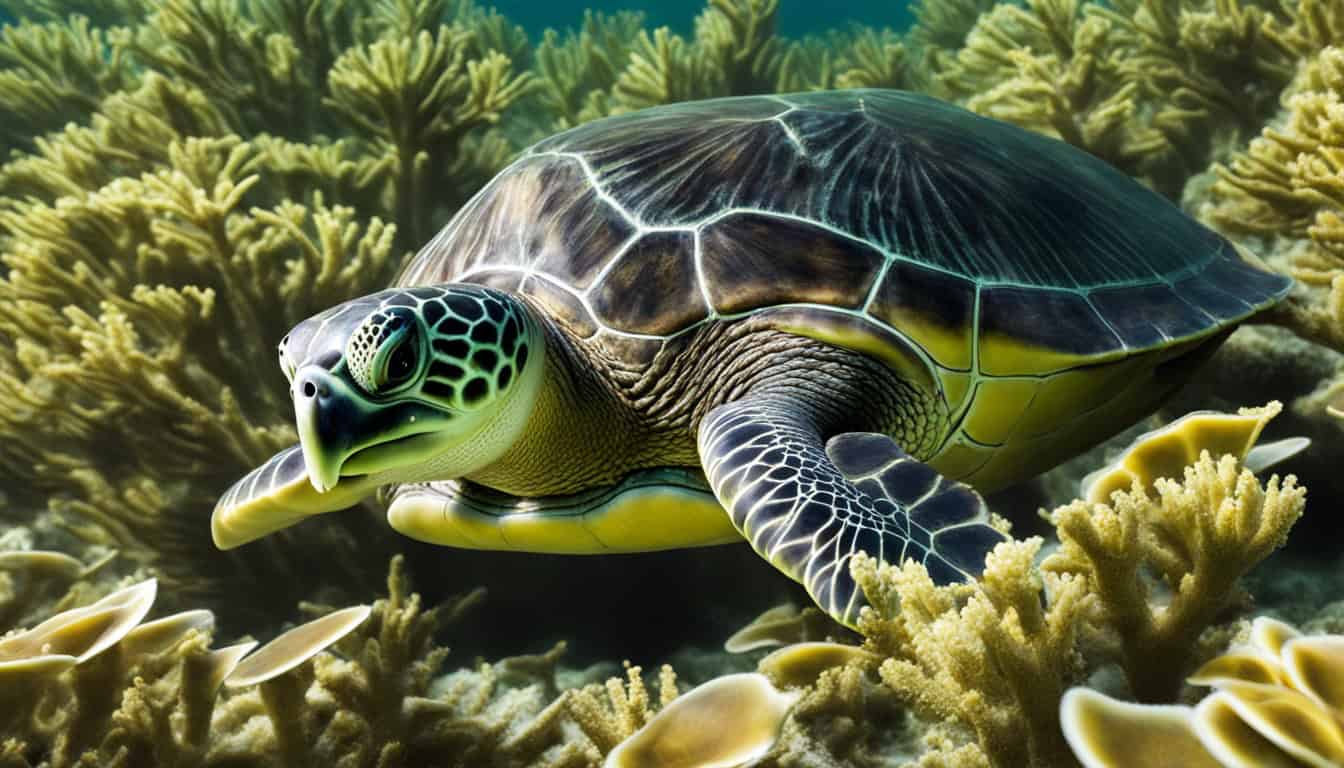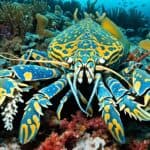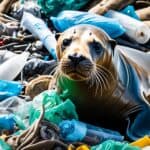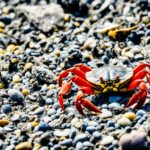Sea turtles have been around for millions of years, but now their numbers are going down. You might ask, why are sea turtles endangered? The main reason is human actions. Six out of seven sea turtle species are endangered or threatened.
This is because of many threats that affect their survival, breeding, and homes. While some threats come from nature, most come from us. It’s our actions that are causing their numbers to drop so fast.
Knowing this is key to saving these amazing creatures. By understanding how our actions affect them, we can help protect them. We all can make a difference in their survival.
The Current Status of Sea Turtles
Sea turtles face a critical situation in terms of global biodiversity. In the United States, six species call our waters home. It’s crucial to understand their conservation status to protect them effectively. Each species has its own set of challenges, making a detailed overview essential.
Overview of Species
In U.S. waters, you’ll find six types of sea turtles: loggerhead, green, leatherback, hawksbill, olive ridley, and Kemp’s ridley. The Endangered Species Act protects them all, with different levels of risk. Hawksbill turtles, for example, are critically endangered due to human actions and habitat loss.
Population Trends
Sea turtles have seen a worrying decline in numbers over the years. Habitat loss, pollution, and more human activity near coasts are to blame. Globally, their numbers are down, especially for hawksbill and leatherback turtles. Knowing this helps us create better conservation plans to save these amazing creatures.
| Species | Status | Estimated Population | Significant Threats |
|---|---|---|---|
| Loggerhead | Threatened | Approximately 50,000 nesting females | Bycatch, habitat loss |
| Green | Threatened | Roughly 10,000 nesting females | Illegal poaching, pollution |
| Leatherback | Vulnerable | About 2,000 nesting females | Climate change, fishing gear |
| Hawksbill | Critically Endangered | Less than 500 nesting females | Marine pollution, habitat degradation |
| Olive Ridley | Vulnerable | Approximately 150,000 nesting females | Bycatch, habitat loss |
| Kemp’s Ridley | Endangered | Only about 1,000 nesting females | Bycatch, coastal development |
Major Threats to Sea Turtles
Sea turtles are facing big challenges that threaten their survival. Two main factors are fisheries impact and habitat destruction. These threats greatly affect sea turtle populations worldwide.
Fisheries and Bycatch
Commercial fishing is a big problem for sea turtles. Bycatch, or catching non-target species, is a major issue. Every year, hundreds of thousands of sea turtles get caught in longlines and gill nets.
This not only leads to immediate deaths but also disrupts their breeding and feeding. These disruptions make life harder for these reptiles.
Habitat Destruction
Coastal development is a big threat to sea turtles’ homes. It destroys beaches and important areas where they live and find food. Things like dredging and building harm their habitats.
Keeping their homes safe is key to their survival. We need to understand how fishing and habitat destruction are connected to help protect sea turtles.

| Threat | Description | Impact on Sea Turtles |
|---|---|---|
| Bycatch | Unintended capture of turtles in fishing gear | High mortality rates, disrupted populations |
| Commercial Fishing | Use of gear like longlines and gill nets | Increased risk of injury and death |
| Habitat Destruction | Coastal development affecting nesting areas | Loss of nesting sites and feeding grounds |
| Illegal Hunting | Poaching and harvesting of turtles | Decreased populations, potential extinction |
Why are sea turtles endangered?
Sea turtles face many dangers that threaten their survival. Pollution is a big problem, harming their chances of living. Climate change adds to the danger, making their world tough.
Pollution Problems
Sea turtles deal with a lot of pollution in the ocean. Plastic in the ocean is a big issue because they think it’s food. This can lead to serious health problems or even death.
They also get caught in fishing gear, which is a big threat. Chemicals from farms and factories harm them too. These chemicals can make their homes unhealthy and mess with their hormones, making it hard for them to have babies.
Light pollution also affects them. It makes them leave their nesting spots. This is a big problem for their survival.
The Role of Climate Change
Climate change is a big problem for sea turtles. Rising sea levels take away their nesting places. And, warmer sand makes more baby turtles female, which can hurt their numbers.
Extreme weather events also hurt them. They destroy where they nest and mess with their homes. We need to understand these issues to help protect sea turtles.
Illegal Activities Impacting Sea Turtles
Sea turtles face big threats from illegal actions. Poaching and the illegal trade of their products are major risks. We need awareness and action to protect them.
Poaching and Harvesting
Poaching sea turtles is a big problem. In places like Central America and Asia, people eat turtle meat and eggs. Even with laws to protect them, poaching goes on. This harms their numbers and the environment.
Illegal Trade of Sea Turtle Products
The illegal trade of sea turtles affects not just the animals but also cultures. Hawksbill sea turtles are hunted for their shells. Their numbers have dropped by up to 90% because of this. We need stronger laws and awareness to save these marine animals.
| Activity | Description | Impact on Sea Turtles |
|---|---|---|
| Poaching | Illegal capture and utilization of turtles for food or products | Population decline, illegal sales |
| Cultural Pressures | Community traditions that prioritize turtle consumption | Increased demand, ethical dilemmas |
| Illegal Trade | Trafficking of turtle shells and egg products | Vulnerability of species, habitat loss |
| Conservation Enforcement | Efforts to prevent poaching and illegal sales | Requires stronger measures for effectiveness |
Conservation Efforts in Place
Many conservation efforts are underway to protect sea turtles and their homes. In the U.S., NOAA Fisheries and the U.S. Fish and Wildlife Service work together. They create recovery plans for both the sea and the coasts where sea turtles live. Laws help protect them and support their recovery.
For sea turtles that migrate across borders, working together with other countries is key. Sharing science and building skills helps conservation. By joining forces, countries can find better ways to protect sea turtles everywhere.
Restoring their habitats is a big part of the plan. This means making their nesting beaches safe again. Teaching people why sea turtles matter is also crucial. Laws are important to stop sea turtles from disappearing, keeping them in our oceans.
FAQ
Why are sea turtles endangered?
Sea turtles face threats from human activities like destroying their homes, hunting them illegally, and polluting their habitats. Six out of seven species are in danger because of these threats.
What are the major threats to sea turtles?
Sea turtles are threatened by bycatch in fishing gear, destruction of their homes, pollution from plastics and chemicals, climate change, and illegal trade of their products. These threats harm their numbers and survival chances.
How does pollution affect sea turtles?
Pollution, including ocean plastics and chemicals, harms sea turtles by causing them to eat and get tangled in debris. It also affects their health and behavior. Light pollution messes with their nesting habits, making it harder for them to survive.
What role does climate change play in the endangerment of sea turtles?
Climate change is a big threat because it changes where sea turtles nest and raises sea levels. It also messes with the sex ratio of hatchlings and makes bad weather events worse, damaging their nesting sites.
What conservation efforts are currently in place for sea turtles?
Conservation efforts include laws under the Endangered Species Act, fixing up their habitats, raising awareness in communities, and working together internationally. These actions help protect their homes and where they lay eggs.
How does illegal poaching impact sea turtle populations?
Illegal hunting and taking sea turtles harm their numbers, especially where people eat their meat and eggs. Even with laws against it, there’s a big problem with illegal sales.
Are there any specific species of sea turtles that are more endangered than others?
Yes, the hawksbill sea turtle is in big trouble because of illegal shell trade. The loggerhead turtle is also threatened. Knowing which species need more protection helps us help them better.







